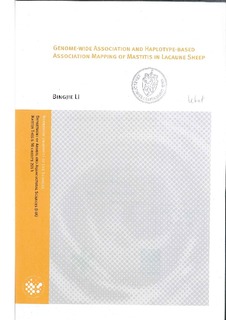| dc.contributor.author | Li, Bingjie | |
| dc.date.accessioned | 2014-02-17T10:35:14Z | |
| dc.date.available | 2014-02-17T10:35:14Z | |
| dc.date.copyright | 2013 | |
| dc.date.issued | 2014-02-17 | |
| dc.identifier.uri | http://hdl.handle.net/11250/186251 | |
| dc.description | This thesis was carried out under joint supervision of both UMB and INRA(Toulouse) in France. | no_NO |
| dc.description.abstract | The aim of this study was to perform a Genome-Wide Association Study (GWAS) and a Haplotype-based Association Mapping to identify potential Quantitative Trail Loci (QTLs) underlying four mastitis-related trails in Lacaune sheep genotyped by the Illumina Ovine 50K SNP chip. The four traits studied included two Somatic Cell Count (SCC)-based traits, and two traits based on mammary abscesses indicating chronic mastitis infection. A total of 393 genotyped animals from two lines of Lacaune sheep previously selected for high and low milk SCC were included in this study, within which 334 ewes were phenotyped based on clinical examinations of udders. The statistical analysis included a Genome-wide Association Study (GWAS) assuming independent markers and a Haplotype-based association study using phasing haplotype clusters. Mixed models accounting for population structure by including polygenic effect in the model were used in both studies. The results indicated five interesting regions on OAR 3, 5, 8, 16 and 20, which were associated with different mastitis-related traits. Among the five regions, OAR16 was assumed to have a potential QTL around 30Mb, since this region was associated with three mastitis-related traits. Region 49.1-49.5Mb on OAR20 was also very interesting since it was associated with one SCC-based trait and two mammary abscess traits. Regions on OAR5 and OAR8 were found to be specifically related to the presence of mammary abscesses, which may infer a specific immune pathway involved in forming mammary abscesses in response to chronic clinical mastitis. In conclusion, this study introduced the mammary abscess as a new phenotype for mastitis and detected two candidate QTLs strongly associated with this phenotype. Introducing new refined mastitis-related traits is important to determine the genetics underlying of mastitis infection. | no_NO |
| dc.description.sponsorship | INRA, France. | no_NO |
| dc.language.iso | eng | no_NO |
| dc.publisher | Norwegian University of Life Sciences, Ås | |
| dc.subject | mastitis | no_NO |
| dc.subject | mammary abscesses | no_NO |
| dc.subject | somatic cell count | no_NO |
| dc.subject | genome-wide association | no_NO |
| dc.subject | haplotye-based association | no_NO |
| dc.title | Genome-wide association and haplotype-based association mapping of mastitis in lacaune sheep | no_NO |
| dc.type | Master thesis | no_NO |
| dc.subject.nsi | VDP::Medical disciplines: 700::Basic medical, dental and veterinary science disciplines: 710::Medical genetics: 714 | no_NO |
| dc.subject.nsi | VDP::Agriculture and fishery disciplines: 900::Agriculture disciplines: 910::Livestock breeding, rearing, reproduction: 912 | no_NO |
| dc.source.pagenumber | 32 | no_NO |
